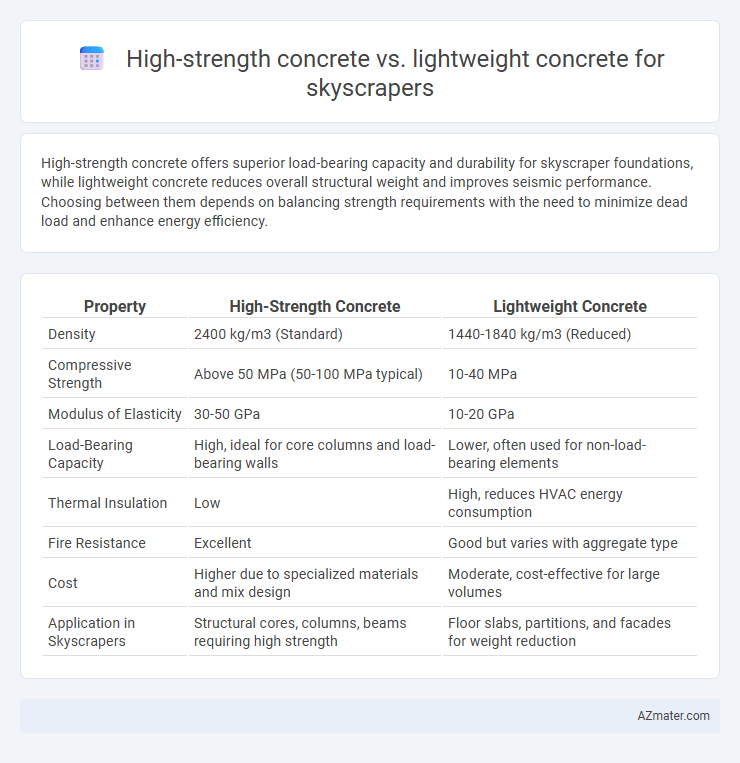High-strength concrete offers superior load-bearing capacity and durability for skyscraper foundations, while lightweight concrete reduces overall structural weight and improves seismic performance. Choosing between them depends on balancing strength requirements with the need to minimize dead load and enhance energy efficiency.
Table of Comparison
| Property | High-Strength Concrete | Lightweight Concrete |
|---|---|---|
| Density | 2400 kg/m3 (Standard) | 1440-1840 kg/m3 (Reduced) |
| Compressive Strength | Above 50 MPa (50-100 MPa typical) | 10-40 MPa |
| Modulus of Elasticity | 30-50 GPa | 10-20 GPa |
| Load-Bearing Capacity | High, ideal for core columns and load-bearing walls | Lower, often used for non-load-bearing elements |
| Thermal Insulation | Low | High, reduces HVAC energy consumption |
| Fire Resistance | Excellent | Good but varies with aggregate type |
| Cost | Higher due to specialized materials and mix design | Moderate, cost-effective for large volumes |
| Application in Skyscrapers | Structural cores, columns, beams requiring high strength | Floor slabs, partitions, and facades for weight reduction |
Introduction to Concrete Types for Skyscrapers
High-strength concrete and lightweight concrete are essential materials used in skyscraper construction, each offering unique structural benefits. High-strength concrete provides enhanced compressive strength, allowing slimmer column designs and greater load-bearing capacity critical for tall buildings. Lightweight concrete reduces overall structural weight, improving seismic performance and easing foundation requirements without compromising durability.
Defining High-Strength Concrete
High-strength concrete (HSC) is defined by its compressive strength exceeding 6,000 psi (approximately 41 MPa), making it suitable for skyscraper construction where load-bearing capacity is critical. HSC achieves enhanced durability and reduced permeability through optimized mix designs incorporating supplementary cementitious materials like silica fume and fly ash. Its superior mechanical properties facilitate slimmer structural elements, enabling taller and more efficient skyscraper designs compared to lightweight concrete, which prioritizes reduced density over compressive strength.
Understanding Lightweight Concrete
Lightweight concrete, characterized by its lower density and enhanced thermal insulation properties, reduces the overall weight load on skyscraper foundations, enabling taller and more efficient structural designs. Its composition typically includes lightweight aggregates such as expanded clay, shale, or pumice, providing sufficient compressive strength while minimizing dead load compared to traditional high-strength concrete. This balance between strength and weight is critical in skyscraper construction, where structural integrity must align with material efficiency and durability under dynamic wind and seismic forces.
Structural Performance Comparison
High-strength concrete offers superior compressive strength, reaching up to 120 MPa, making it ideal for supporting heavy loads in skyscraper construction. In contrast, lightweight concrete, with a typical density of 1600 to 1850 kg/m3, reduces overall structural weight, enhancing seismic performance and foundation efficiency. While high-strength concrete ensures enhanced durability and load-bearing capacity, lightweight concrete improves energy efficiency and reduces dead load stresses on tall structures.
Load-Bearing Capacity in Skyscraper Applications
High-strength concrete offers superior load-bearing capacity crucial for supporting the immense weight and structural demands of skyscrapers, enabling thinner columns and increased floor space. Lightweight concrete, while beneficial for reducing overall building mass and seismic load, typically has lower compressive strength, limiting its use in primary load-bearing elements. Engineers often combine high-strength concrete for core and columns with lightweight concrete in non-structural or infill applications to optimize performance and efficiency in skyscraper construction.
Weight and Material Efficiency
High-strength concrete offers superior load-bearing capacity with a density typically around 2400 kg/m3, optimizing structural performance in skyscrapers by reducing column sizes and increasing usable floor space. Lightweight concrete, generally ranging from 1440 to 1840 kg/m3, significantly lowers the overall building weight, decreasing foundation loads and seismic forces, which improves material efficiency in tall structures. Selecting between these types depends on balancing the need for material strength against weight reduction to maximize skyscraper design efficiency and cost-effectiveness.
Construction Techniques and Challenges
High-strength concrete offers superior load-bearing capacity crucial for skyscraper foundations and core columns but requires precise mixing ratios and temperature control during curing to avoid microcracking. Lightweight concrete reduces overall building weight, improving seismic performance and ease of handling, though challenges include balancing density with structural strength and ensuring proper compaction to prevent voids. Both materials demand advanced quality control and tailored construction methods, such as high-pressure pumping for high-strength mixes and specialized formwork for lightweight aggregates.
Cost Implications and Budget Considerations
High-strength concrete offers superior load-bearing capacity essential for skyscraper stability, but it comes at a higher material and production cost compared to lightweight concrete. Lightweight concrete reduces overall structural weight, leading to potential savings in foundation design and construction expenses, but may require additional investment in admixtures and quality control to meet performance standards. Budget considerations should weigh the long-term benefits of structural efficiency and maintenance costs against initial material and labor expenditures for each concrete type.
Durability and Maintenance Factors
High-strength concrete offers superior durability for skyscrapers due to its increased compressive strength and reduced permeability, minimizing risks of cracking and chemical attacks. Lightweight concrete provides improved seismic performance and thermal insulation but may require more frequent maintenance to address potential micro-cracking and lower abrasion resistance. Selecting high-strength concrete can significantly reduce lifecycle maintenance costs, while lightweight concrete's benefits are balanced by the need for specialized repair strategies.
Best Use Cases: High-Strength vs Lightweight Concrete
High-strength concrete is ideal for skyscrapers requiring exceptional load-bearing capacity and structural stability, particularly in high-rise cores and columns subjected to significant compressive stress. Lightweight concrete excels in reducing overall building weight, thus lowering seismic forces and foundation loads, making it suitable for non-load-bearing elements, facade panels, and floor slabs. Choosing between high-strength and lightweight concrete depends on balancing structural demands with weight considerations to optimize skyscraper performance and safety.

Infographic: High-strength concrete vs Lightweight concrete for Skyscraper
 azmater.com
azmater.com